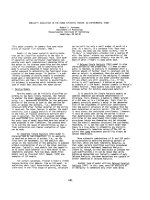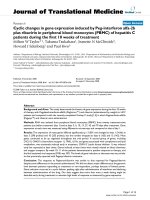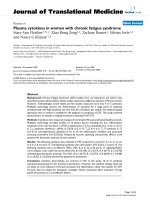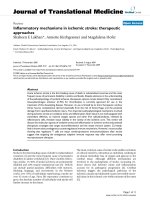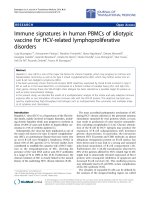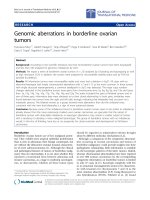Báo cáo hóa học: " Age-related differences in dual task walking: a cross sectional study" ppt
Bạn đang xem bản rút gọn của tài liệu. Xem và tải ngay bản đầy đủ của tài liệu tại đây (312.41 KB, 8 trang )
BioMed Central
Page 1 of 8
(page number not for citation purposes)
Journal of NeuroEngineering and
Rehabilitation
Open Access
Research
Age-related differences in dual task walking: a cross sectional study
Andrew W Priest
†1
, Kathleen B Salamon
†2
and John H Hollman*
†3
Address:
1
Physical Therapy Department, Clarke College, Dubuque, Iowa, USA,
2
Department of Physical Therapy, University of the Pacific,
Stockton, CA, USA and
3
Program in Physical Therapy, Mayo Clinic, Rochester, MN, USA
Email: Andrew W Priest - ; Kathleen B Salamon - ;
John H Hollman* -
* Corresponding author †Equal contributors
Abstract
Background: Variability in stride velocity during walking characterizes gait instability and predicts
falling in older individuals. Walking while executing a cognitive task is also associated with increased
risk of falling, particularly in older adults. Variability in stride velocity, particularly during dual task
walking conditions, may differ between younger and older individuals. The purpose of this study
was to examine whether gait velocity and variability in stride velocity differ between older
community-dwelling women and younger women during dual task walking.
Methods: Twenty-three older (80 ± 9 years) and 19 younger (23 ± 2 years) women walked under
each of two conditions: (1) walking at a self-selected velocity and (2) walking at a self-selected
velocity while incrementally counting backwards. Gait velocity and variability in stride velocity were
measured with GAITRite
®
instrumentation.
Results: Gait velocity decreased and variability in stride variability increased, in both groups, during
dual task walking. The relative reduction in gait velocity and the magnitude of variability in stride
velocity were greater in the older subjects than younger subjects.
Conclusion: The gait changes observed in dual task walking characterize reduced gait stability and
indicate that cognitively demanding tasks during walking have a destabilizing effect on gait that may
place older persons at greater risk of falls.
Background
Postural stability is classically defined as the ability to con-
trol displacements of one's center of mass (COM) relative
to one's base of support (BOS) [1]. Walking is a dynamic
task whereby the COM and BOS are constantly changing;
hence, gait stability can be defined as the ability to control
displacements of one's COM in relationship to a con-
stantly changing BOS. Measuring gait stability as defined,
however, requires sophisticated laboratory instrumenta-
tion that is not entirely conducive to clinical assessment
purposes. Rather than measuring COM and BOS relation-
ships during walking, investigators have recognized that
stride-to-stride variability in gait predicts falls in older per-
sons and distinguishes those who are at increased falls risk
[2,3]. As such, increased stride variability can serve as a
marker of gait instability.
Gait instability has been observed in many older adults,
even in absence of pathology [4]. In individuals with neu-
rologic pathology, deficits in the central nervous system's
ability to coordinate motor outputs are largely responsi-
ble for gait instability [5]. It is not entirely clear why gait
Published: 14 November 2008
Journal of NeuroEngineering and Rehabilitation 2008, 5:29 doi:10.1186/1743-0003-5-29
Received: 12 February 2008
Accepted: 14 November 2008
This article is available from: />© 2008 Priest et al; licensee BioMed Central Ltd.
This is an Open Access article distributed under the terms of the Creative Commons Attribution License ( />),
which permits unrestricted use, distribution, and reproduction in any medium, provided the original work is properly cited.
Journal of NeuroEngineering and Rehabilitation 2008, 5:29 />Page 2 of 8
(page number not for citation purposes)
instability occurs in older individuals who do not have
apparent neurologic pathology. The reasons are most
likely multifactorial, including deficits in physiologic
function such as impaired joint range of motion and mus-
cle performance and deficits in neuropsychological or
cognitive status that may exacerbate the effects of
impaired physiologic capacity [6-8]. Several studies have
examined age-related changes in gait stability over the
past decade [3,4,9-13]. Among the findings, initial inves-
tigations suggest that increased stride variability may be a
more powerful predictor of falling than any of the static
measures of balance [3].
Walking has long been considered an automatic or reflex
controlled task requiring motor responses to sensory stim-
uli, but requiring minimal cognitive resources. Given that
gait changes are observed in older adults in absence of
identified pathology [3,11,13], however, investigators
have begun studying the influence of cognitive effects on
gait stability using dual task paradigms whereby subjects
perform a cognitive task while walking [9,14-16]. Lundin-
Olsson, et al. [16], for example, suggested that many falls
in balance-impaired older individuals do not typically
occur during normal walking conditions, but rather when
they are walking and simultaneously performing a sec-
ondary task such as talking.
The influence of cognitive activity on gait has been studied
in patient populations and results consistently show that
persons with neurologic pathology walk with decreased
gait velocity and increased gait variability in dual task con-
ditions [17-20]. Studies on the effects of cognitive activity
on gait stability in the otherwise well-elderly, however,
have had mixed results. Yogev et al. [20] and Springer et
al. [21] reported that gait velocity decreased in older
healthy subjects during dual task walking but that stride-
to-stride variability did not differ between normal and
dual task walking conditions. Both studies concluded that
the regulation of gait variability does not require atten-
tional capacities in healthy older persons. Alternatively,
additional studies have provided evidence that increases
in stride variability in addition to decreases in gait velocity
occur in healthy older adults who perform a cognitive task
while walking [9,10,15,22]. Methodological differences
between the studies may account for the contrasting
results. Yogev et al. and Springer et al., for example, meas-
ured swing time variability over a relatively large number
of strides (40–50 strides). Other studies [9,10,15,22], in
contrast, measured variability in stride velocity but over
fewer strides. Furthermore, Dubost et al. [23] reported
that attention-demanding tasks affect stride time variabil-
ity, independent of changes in velocity, but not stride
length variability. It is therefore possible that the variation
in gait parameters measured led to the different outcomes
among the studies. Perhaps variability in stride velocity,
spatial stance and swing parameters or temporal stance
and swing parameters reflect different aspects of gait sta-
bility. Variability in stride velocity, for example, is a
stronger predictor of falls in older adults than other gait
parameters [3] and therefore may be more relevant as
marker of gait instability than swing time variability. On
the other hand, variability in stride velocity measured over
relatively few strides (e.g., 11–20 strides reported by Hol-
lman et al. [10]) may be less reliable than the same meas-
ure quantified over a greater number of strides.
Given the limited number of strides analyzed in previous
studies [9,10,15,22], but recognizing the potential value
of measuring variability in stride velocity as it pertains to
falls risk in older people [3], assessing whether there are
age-related differences in variability in stride velocity dur-
ing dual task walking over a greater number of strides war-
rants further investigation. The purpose of this cross-
sectional study was to investigate whether variability in
stride velocity increases in well-elderly subjects during
dual task walking, specifically when compared with
younger adults, over a greater number of strides than pre-
vious studies have considered. We hypothesized that var-
iability in stride velocity would increase in older subjects
during dual task walking and that variability in stride
velocity would be greater in older subjects than younger
subjects.
Methods
Participants
In a pilot study [15] conducted preliminary to the present
study, variability in stride velocity in older subjects
increased from a coefficient of variation (CV) of 4.9% CV
in a normal walking condition to 16.4% CV in a dual task
walking condition. To detect a comparable difference in
the magnitude of variability in stride velocity of 10% CV,
with standard deviations of 7% CV, at
α
= 0.05 and at a
statistical power of 0.90, minimally 10 subjects per group
were required to participate. For this study we recruited 19
younger and 23 older subjects, a conservative number of
subjects estimated to detect a 10-point change in variabil-
ity in stride velocity at a statistical power of 0.90 or to
detect a 5-point change in variability in stride velocity at a
statistical power of 0.80. The power analysis was con-
ducted with WINPEPI software [24]. Demographic data
are presented in Table 1.
Each participant in the older subject group was a self-
reported healthy, community-dwelling resident of Mount
St. Francis or Mount Carmel, residence facilities for active
and retired women who are members of religious orders,
in Dubuque, IA, USA. Exclusion criteria consisted of
chronic or acute musculoskeletal or neuromuscular
pathology that restricted independent walking, a self-
reported history of falling, and dependence on an assistive
Journal of NeuroEngineering and Rehabilitation 2008, 5:29 />Page 3 of 8
(page number not for citation purposes)
device (e.g., cane or walker) for independent walking. Par-
ticipants in the younger subject group were volunteers
from the student population at Clarke College (Dubuque,
IA). All participants provided informed consent. The
Clarke College institutional review board approved the
study.
Instrumentation
Data were collected with GAITRite
®
instrumentation (CIR
Systems Inc., Clifton, NJ). The GAITRite
®
system consists
of a 3.66 meter rubberized digital walkway with software
for data acquisition and processing. Over 13,000 pressure
sensors are embedded within the walkway. As subjects
walk across the mat, sensors are activated under pressure
at footfall then deactivated at toe-off, enabling spatial and
temporal gait data to be collected. Data are sampled at a
frequency of 80 Hz, then processed and stored on an IBM
compatible computer using GAITRite
®
Gold software.
GAITRite
®
instrumentation has been reported to have high
reliability (ICCs ≥ 0.85) and high concurrent validity
when compared with video-based motion analysis sys-
tems (ICCs ≥ 0.93) for spatial and temporal parameters of
gait such as velocity, cadence, and stride length [25,26].
Procedures
For the normal walking trials, subjects were instructed to
walk at self-selected speeds across the walkway. Under the
dual task walking condition, subjects were instructed sim-
ilarly but in addition they verbally counted backward
from 100, subtracting in increments of 3, 4, or 6. The cog-
nitive task we incorporated was similar to the backward-
counting-by-3 task used in previous studies [27,28] to
manipulate the attention demands of subjects during a
motor task. Additionally, to reduce potential practice or
learning effects from trial to trial, a different integer was
used across successive trials. The order in which each inte-
ger (3, 4, or 6) was assigned for each trial in the dual task
condition was selected randomly by the investigator.
Since we were interested in the potential effects of the cog-
nitive task on changes in gait dynamics and gait instabil-
ity, and were not necessarily concerned with subjects'
performance on the cognitive task itself, we did not eval-
uate performance on the cognitive task. One investigator
walked beside the elderly subjects and adjacent to the
walkway during the dual task condition to provide sup-
port if a loss of balance occurred. Data from such trials
were not included in the analysis, and subjects were asked
to repeat the trial.
Subjects initiated each walking trial one meter in front of
the walkway, ambulated over the walkway, and termi-
nated the trial one meter beyond the walkway to reduce
potential acceleration and deceleration effects of gait ini-
tiation and termination on the instrumented walkway.
Each walking trial therefore occurred over a distance
exceeding 5.5 meters. In the dual task condition subjects
started counting backwards as they initiated their walking
trials and continued the task until they terminated the
trial. Ten walking trials under each condition were
recorded for each subject.
The length of the walkway allowed us to collect between
three and eight strides during any individual trial,
depending on a subject's stride length. While step lengths
can vary between right and left sides during walking, a
stride is composed of one right step and one left step (or
conversely, one left step followed by one right step) and
as a result little variation occurs in stride length between
right and left sides. We therefore collapsed right and left
strides across each of the trials within a walking condition
for our data analysis. We collected an average of 57 strides
(SD = 20 strides) from subjects in the older age group and
30 strides (SD = 5 strides) from subjects in the younger age
group.
Gait velocity (cm/s) was measured directly from the foot-
falls recorded with the GAITRite
®
instrumentation. The
velocity of individual strides was also recorded with the
GAITRite
®
instrumentation. Stride velocity (cm/s) was cal-
culated as stride length divided by stride time. Stride
length is defined as the linear distance (in cm) between
successive heel contacts of the same foot. Stride time is
defined as the duration (in seconds) over which one stride
occurs.
Data Analysis
We operationally defined gait instability as variability in
stride velocity. We quantified variability in stride velocity
Table 1: Demographic Data (mean ± SD)
Group Age (years) Height (cm) Mass (kg)
Younger Group (n = 19) 22.7 ± 1.1 167.3 ± 7.8 72.9 ± 12.6
Older Group (n = 23) 79.8 ± 8.6 154.4 ± 8.5 70.2 ± 13.2
Journal of NeuroEngineering and Rehabilitation 2008, 5:29 />Page 4 of 8
(page number not for citation purposes)
as the percentage coefficient of variation (CV) across mul-
tiple strides collected from ten walking trials. CV is deter-
mined by the equation,
where SD = standard deviation and = mean. The CV is
a measure of relative variation most meaningful when
comparing the variability of distributions, such as that
obtained from two groups of subjects. In addition to var-
iability in stride velocity, we also measured average gait
velocity in both subject groups. Gait velocity, while less
powerful an indicator of gait instability than stride varia-
bility [3], is commonly used to characterize dynamic gait
kinematics.
Descriptive data (mean ± SD) across walking conditions
were calculated. Two 2 × 2 mixed model analyses of vari-
ance (ANOVAs) having one between-subjects factor
(group: younger and older subjects) and one within-sub-
jects factor (condition: normal and dual task walking)
were conducted to analyze differences in mean gait veloc-
ity and variability in stride velocity (
α
= 0.05). Post hoc t-
tests with the Bonferroni-adjusted
α
were conducted
when necessary to identify the comparisons that were sta-
tistically significant.
Results
Gait velocity data are presented in Figure 1. Older subjects
walked more slowly than younger subjects during both
walking conditions [F(1,40) = 90.25, p < 0.001]. Each
subject, whether younger or older, walked more slowly in
the dual task walking condition than in the normal walk-
ing condition [F(1,40) = 61.71, p < 0.001]. On average,
gait velocity decreased by 18% in the younger group and
gait velocity decreased by 30% in the older group [t(40) =
2.118, p = 0.040].
The effects of cognitive activity on stride variability are
illustrated in Figures 2 and 3. Figure 3 presents a charac-
teristic example of the effect of dual tasking on both gait
velocity and variability in stride velocity. Overall, older
subjects walked with greater variability in stride velocity
than younger subjects during both walking conditions
[F(1.40) = 13.23, p = 0.001]. Both groups of subjects
walked with greater variability in stride velocity in the
dual task walking condition than in the normal walking
condition [F(1,40 = 20.28, p < 0.001]. In younger sub-
jects, relatively little variability in stride velocity was
observed in the normal walking condition (4.8 ± 1.8%
CV); variability in stride velocity increased in the dual task
walking condition (8.5 ± 4.9% CV). The difference in var-
iability in stride velocity between conditions in younger
subjects was statistically significant [t(18) = 3.608, p =
0.002]. Similarly, older subjects walked with less variabil-
ity in stride velocity in the normal walking condition (8.2
± 3.6% CV) than in the dual task walking condition (14.9
± 9.2% CV); the difference in variability in stride velocity
between conditions was statistically significant [t(22) =
3.475, p = 0.002]. The greatest variability in stride velocity
observed in the study occurred among older subjects in
the dual task walking condition [t(40) = 2.714, p = 0.010].
CV SD X=
()
× 100
X
Gait VelocityFigure 1
Gait Velocity. Gait velocity in the normal and dual task
walking conditions (error bars represent one standard devia-
tion). The difference in gait velocity between the normal and
dual task walking conditions is statistically significant [F(1,40)
= 61.713, p < 0.001]. The difference in gait velocity between
older and younger subjects is statistically significant [F(1,40)
= 90.247, p < 0.001].
0
25
50
75
100
125
150
175
Normal Dual Task
Walking Condition
Younger
Subjects
Older
Subjects
Variability in stride velocityFigure 2
Variability in stride velocity. Variability in stride velocity
in the normal and dual task walking conditions, as quantified
with the coefficient of variation (error bars represent one
standard deviation). The difference in variability in stride
velocity between the normal and dual task walking conditions
is statistically significant [F(1,40) = 20.281, p < 0.001]. The
difference in variability in stride velocity between older and
younger subjects is statistically significant [F(1,40) = 13.232, p
= 0.001].
0
5
10
15
20
25
Normal Dual Task
Walking Condition
Younger
Subjects
Older
Subjects
Journal of NeuroEngineering and Rehabilitation 2008, 5:29 />Page 5 of 8
(page number not for citation purposes)
Discussion
Similar to the results of previous studies [9,10,15,22], this
study provides evidence that cognitive activity during
walking reduces gait velocity and increases variability in
stride velocity in well-elderly women. The magnitude of
reduction in gait velocity observed among older subjects
in dual task walking in the present study, approximately
24.0 cm/s, is comparable to the 24.5 cm/s reduction
reported by Hollman et al. [10]. The magnitude of
increase in variability in stride velocity during dual task
walking, approximately 6.7% CV, is comparable to the
6.9% CV magnitude of change reported by Beauchet et al.
[9].
A strength of the present study is that the number of
strides analyzed per subject increased two- to several-fold
compared to previous studies measuring similar gait
parameters [9,10,15,22]. While the number of strides
required to measure variability in stride velocity reliably is
not known, previous studies indicate that limited stride
numbers may influence the measure's reliability. Besser et
al. [29], for example, reported that 5 to 8 strides are nec-
essary for 90% of individuals tested with GAITRite
®
instru-
mentation to have reliable mean estimates of
spatiotemporal gait parameters including velocity, stride
and step length, and step and single support time. Other
parameters, including base of support width and double
support time, required greater than 10 strides to yield reli-
able data. Additional research indicated that while meas-
urement of spatiotemporal gait parameters including
velocity and cadence is highly reliable with GAITRite
®
instrumentation when subjects perform 3 trials per test
[30], measurement of variability in stride velocity is less
reliable with a similar number of trials and therefore may
require that a greater number of strides be analyzed [31].
Based on such studies, it is evident that analyzing greater
numbers of strides produces more reliable gait data when
the parameters being measured are inherently more varia-
ble.
While we cannot ascertain precise reliability coefficients
of the data measured in the present study, we can apply
the Spearman-Brown prophecy formula to estimate relia-
bility of variability in stride velocity data. The Spearman-
Brown prophecy formula is denoted as [32]
where
ρ
* is the projected reliability coefficient, N repre-
sents the additional sets of strides analyzed, and
ρ
xx'
is the
known reliability coefficient. Assuming that the test-retest
reliability coefficient for variability in stride velocity dur-
ing normal walking is 0.66 based on data collected over
ρ
ρ
ρ
∗
=
+−
()
N
xx
N
xx
’
’
11
Characteristic example of stride velocityFigure 3
Characteristic example of stride velocity. Characteristic example of stride velocity in an 87 year old woman. Mean veloc-
ity in the normal walking condition is 67.1 cm/s and variability in stride velocity, as quantified with the coefficient of variation
(CV), is 5.9% CV. Mean velocity in the dual task walking condition is 37.6 cm/s and stride-to-stride variability in velocity is
25.3% CV.
0
10
20
30
40
50
60
70
80
1 6 11 16 21 26 31 36 41 46 51 56 61 66 71 76
Stride Number
Velocity (cm/s)
Normal
Walking
Dual Task
Walking
Journal of NeuroEngineering and Rehabilitation 2008, 5:29 />Page 6 of 8
(page number not for citation purposes)
13 strides [31], for example, application of the Spearman-
Brown prophecy formula indicates that the projected reli-
ability of variability in stride velocity increases to approx-
imately 0.90 when data are collected over 57 strides, a
factor 4.4 times greater than the number of strides col-
lected in the cited study. Stride variability data obtained in
the present study are therefore projected to be more relia-
ble than results of similar work [9,10,15,22] in which
GAITRite
®
instrumentation has been used to quantify
stride variability. Since results in the present study are con-
sistent with results of those studies, confidence is
enhanced that the dual tasking effects represent real effects
of cognitive demands on gait performance rather than
natural variations that may occur in gait.
An increase in variability from one stride to the next,
whether the measure reflects variability in step length
[33], variability in stride time [4,5,17,19], or variability in
stride velocity [3,9,10,15,22], reflects an impaired ability
to regulate stride-to-stride variations in gait timing. The
increase in stride variability therefore reflects gait instabil-
ity. We chose to analyze specifically subjects' variability in
stride velocity because, of the various gait parameters
reflecting gait instability, it appears to be the best predic-
tor of future incidence of falls in elderly individuals [3].
Lundin-Olsson et al. [16] and others [34] have suggested
that cognitive activity during walking may increase the
risk of falling in older individuals. While this study did
not examine risk of falling, results concur that performing
a cognitive activity during walking does influence gait
instability in older women. The threshold at which varia-
bility in stride velocity during dual task walking predicts
an elevated risk of falling has not, to our knowledge, been
determined. Nevertheless, we believe that the conse-
quence of cognitive activity during walking needs to be
considered by clinicians and researchers alike who work
with individuals with impaired balance or with those who
may be at elevated risk of falling.
Results of the study have several clinical implications.
Foremost, a clinician must recognize that attention-
demanding tasks have a destabilizing effect on gait, partic-
ularly in older individuals. Recognizing the influence of
cognitive activity on gait and gait stability, a clinician may
instruct older individuals who are at risk of falling to
avoid performing cognitive tasks while they are walking.
Alternatively, a clinician may recognize the utility of dual
tasking and choose to engage the individual in cognitive
activities while walking in an effort to improve the per-
son's ability to perform dual tasks in a safe and functional
manner. While no large scale studies, to our knowledge,
have addressed these issues from a clinical perspective,
Maki [3] and Hausdorff et al. [35] suggest that gait stabil-
ity improves with exercise, although they did not examine
the question under dual task walking conditions. Silsupa-
dol et al. [36] provide evidence through case reports that
two patients who received balance training under dual
task conditions showed benefits maintained over 3
months that were not evident in a patient who trained
under a single task balance training program. Whether
training under dual task conditions can improve gait or
fall risk during dual task walking needs further investiga-
tion.
Interpreting results of the present study is limited some-
what by its relatively nonspecific inclusion and exclusion
criteria. Each older subject described herself as a commu-
nity-dwelling, healthy woman without a history of falls
and without pathology that restricted independent walk-
ing. There are, however, potentially many other factors
not addressed in pre-test screening that may have other-
wise classified the subjects as being at risk for falling or as
being susceptible to gait instability. Examples include cog-
nitive status [37], medication history [38,39], other meas-
ures of static or dynamic balance [37] and other measures
of physical function [40]. For instance, some of the data
in our study suggest that the older subjects we studied may
not have been entirely void of fall risk. Reduced gait veloc-
ity is not necessarily a predictor of gait instability or a risk
factor for falls, but may be a symptom of a person's fear of
falling [3]. The older subjects in our study walked more
slowly (79 cm/s) than similar healthy, community-dwell-
ing subjects in other studies (approximately 100 cm/s
[33,35]) and some, such as the individual represented in
Figure 3, may have walked at gait velocities below that
typically seen in community ambulators [41] or may have
been at risk of falling. Additionally, the study included
women only and therefore results should not be general-
ized to men. Despite the limitations, the study adds to a
growing body of evidence [9,10,15,22] that dual tasking
influences gait performance and gait stability and that the
effect is particularly pronounced in older individuals.
Conclusion
Gait velocity decreased and variability in stride velocity
increased, in both young women and older community-
dwelling women, during dual task walking. The relative
reduction in gait velocity and increased magnitude of var-
iability, however, were more pronounced in the older par-
ticipants. Gait variability observed in the dual task
walking condition characterizes impaired execution of
gait that reflects gait instability and indicates that cogni-
tively challenging tasks performed while walking may
place older persons at greater risk of falls.
List of abbreviations
ANOVA: analysis of variance; BOS: base of support; COM:
center of mass; CV: coefficient of variation; ICC: intraclass
correlation coefficient; SD: standard deviation
Journal of NeuroEngineering and Rehabilitation 2008, 5:29 />Page 7 of 8
(page number not for citation purposes)
Competing interests
The authors declare that they have no competing interests.
Authors' contributions
AWP participated in the design of the study, participated
in the data collection, and contributed to the writing of
the document. KBS participated in the design of the study,
participated in the data collection, and contributed to the
writing of the document. JHH participated in the design of
the study, conducted the data analysis, and contributed to
writing of the document. All authors read and approved
the final manuscript.
Acknowledgements
This study was self-funded. Equipment used is owned by the Clarke College
Physical Therapy Department.
References
1. Shumway-Cook A, Woollacott M: Motor Control: Translating
Research into Clinical Practice. 3rd edition. Philadelphia, PA:
Lippincott Williams & Wilkins; 2007.
2. Hausdorff JM, Rios DA, Edelberg HK: Gait variability and fall risk
in community-living older adults: a 1-year prospective study.
Arch Phys Med Rehabil 2001, 82(8):1050-1056.
3. Maki BE: Gait changes in older adults: predictors of falls or
indicators of fear. J Am Geriatr Soc 1997, 45(3):313-320.
4. Hausdorff JM, Edelberg HK, Mitchell SL, Goldberger AL, Wei JY:
Increased gait unsteadiness in community-dwelling elderly
fallers. Arch Phys Med Rehabil 1997, 78(3):278-283.
5. Hausdorff JM, Cudkowicz ME, Firtion R, Wei JY, Goldberger AL: Gait
variability and basal ganglia disorders: stride-to-stride varia-
tions of gait cycle timing in Parkinson's disease and Hunting-
ton's disease. Mov Disord 1998, 13(3):428-437.
6. Catena RD, van Donkelaar P, Chou LS: Cognitive task effects on
gait stability following concussion. Exp Brain Res 2007,
176(1):23-31.
7. Horak FB: Postural orientation and equilibrium: what do we
need to know about neural control of balance to prevent
falls? Age Ageing 2006, 35(Suppl 2):ii7-ii11.
8. Krebs DE, Jette AM, Assmann SF: Moderate exercise improves
gait stability in disabled elders. Arch Phys Med Rehabil 1998,
79(12):1489-1495.
9. Beauchet O, Kressig RW, Najafi B, Aminian K, Dubost V, Mourey F:
Age-related decline of gait control under a dual-task condi-
tion. J Am Geriatr Soc 2003, 51(8):1187-1188.
10. Hollman JH, Kovash FM, Kubik JJ, Linbo RA: Age-related differ-
ences in spatiotemporal markers of gait stability during dual
task walking. Gait Posture 2007, 26(1):113-119.
11. Menz HB, Lord SR, Fitzpatrick RC: Age-related differences in
walking stability. Age Ageing 2003, 32(2):137-142.
12. Shumway-Cook A, Gruber W, Baldwin M, Liao S: The effect of
multidimensional exercises on balance, mobility, and fall risk
in community-dwelling older adults. Phys Ther
1997,
77(1):46-57.
13. Grabiner PC, Biswas ST, Grabiner MD: Age-related changes in
spatial and temporal gait variables. Arch Phys Med Rehabil 2001,
82(1):31-35.
14. Ebersbach G, Dimitrijevic MR, Poewe W: Influence of concurrent
tasks on gait: a dual-task approach. Percept Mot Skills 1995,
81(1):107-113.
15. Hollman JH, Salamon KB, Priest AW: Age-related differences in
stride-to-stride variability during dual task walking: a pilot
study. J Geriatr Phys Ther 2004, 27(3):83-87.
16. Lundin-Olsson L, Nyberg L, Gustafson Y: "Stops walking when
talking" as a predictor of falls in elderly people. Lancet 1997,
349(9052):617.
17. Hausdorff JM, Balash J, Giladi N: Effects of cognitive challenge on
gait variability in patients with Parkinson's disease. J Geriatr
Psychiatry Neurol 2003, 16(1):53-58.
18. Hausdorff JM, Schaafsma JD, Balash Y, Bartels AL, Gurevich T, Giladi
N: Impaired regulation of stride variability in Parkinson's dis-
ease subjects with freezing of gait. Exp Brain Res 2003,
149(2):187-194.
19. Sheridan PL, Solomont J, Kowall N, Hausdorff JM: Influence of
executive function on locomotor function: divided attention
increases gait variability in Alzheimer's disease. J Am Geriatr
Soc 2003, 51(11):1633-1637.
20. Yogev G, Giladi N, Peretz C, Springer S, Simon ES, Hausdorff JM:
Dual tasking, gait rhythmicity, and Parkinson's disease:
which aspects of gait are attention demanding? Eur J Neurosci
2005, 22(5):1248-1256.
21. Springer S, Giladi N, Peretz C, Yogev G, Simon ES, Hausdorff JM:
Dual-tasking effects on gait variability: the role of aging, falls,
and executive function. Mov Disord 2006, 21(7):950-957.
22. Beauchet O, Dubost V, Aminian K, Gonthier R, Kressig RW: Dual-
task-related gait changes in the elderly: does the type of cog-
nitive task matter? J Mot Behav 2005, 37(4):259-264.
23. Dubost V, Annweiler C, Aminian K, Najafi B, Herrmann FR, Beauchet
O: Stride-to-stride variability while enumerating animal
names among healthy young adults: result of stride velocity
or effect of attention-demanding task? Gait Posture 2008,
27(1):138-143.
24. Abramson JH: WINPEPI (PEPI-for-windows): computer pro-
grams for epidemiologists. Epidemiol Perspect Innov 2004, 1:6.
25. Bilney B, Morris M, Webster K: Concurrent related validity of
the GAITRite walkway system for quantification of the spa-
tial and temporal parameters of gait. Gait Posture 2003,
17(1):68-74.
26. McDonough AL, Batavia M, Chen FC, Kwon S, Ziai J: The validity
and reliability of the GAITRite system's measurements: A
preliminary evaluation. Arch Phys Med Rehabil 2001,
82(3):419-425.
27. Maylor EA, Wing AM: Age differences in postural stability are
increased by additional cognitive demands. J Gerontol B Psychol
Sci Soc Sci 1996, 51(3):P143-154.
28. Pellecchia GL: Postural sway increases with attentional
demands of concurrent cognitive task. Gait Posture 2003,
18(1):29-34.
29. Besser MP, Kmieczak K, Schwartz L, Snyderman M, Wasko J, Selby-
Silverstein L: Representation of temporal spatial gait parame-
ters using means in adults without impairment. Gait Posture
1999, 9(2):113.
30. Menz HB, Latt MD, Tiedemann A, Mun San Kwan M, Lord SR: Relia-
bility of the GAITRite walkway system for the quantification
of temporo-spatial parameters of gait in young and older
people. Gait Posture 2004, 20(1):20-25.
31. Hollman JH, Youdas JW, Childs KB, McNeil ML, Quilter CM, Mueller
AC: Reliability and responsiveness of stride variability in gait.
Minnesota American Physical Therapy Association 2008 Spring Conference
2008 [ />]. Brooklyn Center,
MN
32. Nunnally JC, Bernstein IH: Psychometric Theory. 3rd edition.
New York, NY: McGraw-Hill, Inc; 1994.
33. Brach JS, Berthold R, Craik R, VanSwearingen JM, Newman AB: Gait
variability in community-dwelling older adults. J Am Geriatr Soc
2001, 49(12):1646-1650.
34. de Hoon EW, Allum JH, Carpenter MG, Salis C, Bloem BR, Conzel-
mann M, Bischoff HA: Quantitative assessment of the stops
walking while talking test in the elderly. Arch Phys Med Rehabil
2003, 84(6):838-842.
35. Hausdorff JM, Nelson ME, Kaliton D, Layne JE, Bernstein MJ, Nuern-
berger A, Singh MA: Etiology and modification of gait instability
in older adults: a randomized controlled trial of exercise. J
Appl Physiol 2001, 90(6):2117-2129.
36. Silsupadol P, Siu KC, Shumway-Cook A, Woollacott MH: Training
of balance under single- and dual-task conditions in older
adults with balance impairment. Phys Ther 2006, 86(2):269-281.
37. Tinetti ME, Doucette J, Claus E, Marottoli R: Risk factors for seri-
ous injury during falls by older persons in the community. J
Am Geriatr Soc 1995, 43(11):1214-1221.
38. Ensrud KE, Blackwell TL, Mangione CM, Bowman PJ, Whooley MA,
Bauer DC, Schwartz AV, Hanlon JT, Nevitt MC: Central nervous
system-active medications and risk for falls in older women.
J Am Geriatr Soc 2002, 50(10):1629-1637.
Publish with Bio Med Central and every
scientist can read your work free of charge
"BioMed Central will be the most significant development for
disseminating the results of biomedical research in our lifetime."
Sir Paul Nurse, Cancer Research UK
Your research papers will be:
available free of charge to the entire biomedical community
peer reviewed and published immediately upon acceptance
cited in PubMed and archived on PubMed Central
yours — you keep the copyright
Submit your manuscript here:
/>BioMedcentral
Journal of NeuroEngineering and Rehabilitation 2008, 5:29 />Page 8 of 8
(page number not for citation purposes)
39. Leipzig RM, Cumming RG, Tinetti ME: Drugs and falls in older
people: a systematic review and meta-analysis: I. Psycho-
tropic drugs. J Am Geriatr Soc 1999, 47(1):30-39.
40. de Rekeneire N, Visser M, Peila R, Nevitt MC, Cauley JA, Tylavsky FA,
Simonsick EM, Harris TB: Is a fall just a fall: correlates of falling
in healthy older persons. The health, aging and body compo-
sition study. J Am Geriatr Soc 2003, 51(6):841-846.
41. Perry J, Garrett M, Gronley JK, Mulroy SJ: Classification of walking
handicap in the stroke population. Stroke 1995, 26(6):982-989.
